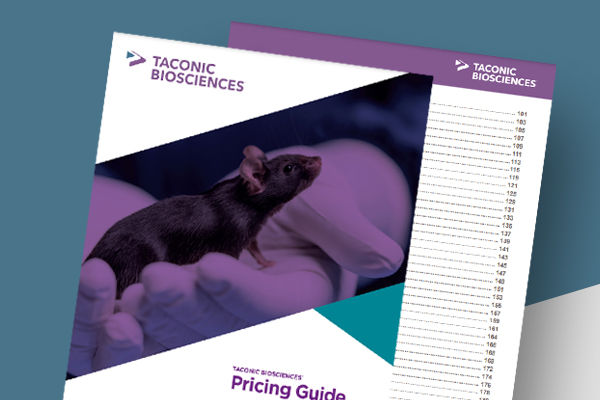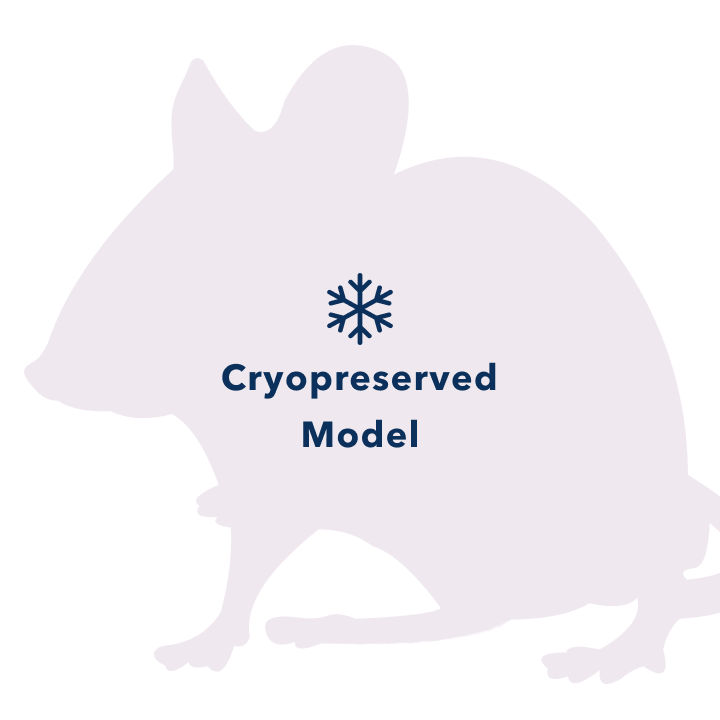| Model No. | Nomenclature | Genotype |
|---|---|---|
| 584-F | C.129P2(B6)-Fcer1gtm1Rav N12 | ko/ko |
| 584-M | C.129P2(B6)-Fcer1gtm1Rav N12 | ko/ko |
Fcer1g - Model 584

- Description
- Related Products & Services
- Price & Licensing
- Health Report
- Overview
- Genetics
- Guides & Publications
- Applications & Therapeutic Areas
- Transit, Housing & Welfare
- Diet
Overview
Nomenclature: C.129P2(B6)-Fcer1gtm1Rav N12
- Deficient in the gamma chain subunit of the FcgRI, FcgRIII, and FceRI receptors
- The deleted gamma chain subunit is essential for cell surface expression of these molecules
- Macrophages, neutrophils, mast cells, basophils, and NK cells are functionally impaired, due to the lack of these Fc receptors
- The mice have normal T cell thymic and peripheral T cell development
- Useful in determining the role of structurally similar Fc receptors in mediating effector immune responses and studying the pleiotropic role of the γ chain subunit
- Exhibit several different types of immunodeficiency making them useful for studies to distinguish the role of the Fc Receptors in antibody-mediated effector responses and to evaluate the contribution of IgG and IgE triggered effector pathways
- The mice are fertile and develop normally
- These mice carry the H2d haplotype
Origin
The Fcer1g mouse was developed in the laboratory of J.V. Ravetch in 1993. The model was created by targeting the Fcer1g gene in E14 ES cells and injecting the targeted cells into C57BL/6 blastocysts. Heterozygotes on a C57BL/6 background were intercrossed to generate homozygous targeted mutation mice. The mice were then backcrossed twelve generations (N12) to a BALB/cByJ inbred background. The mice were further backcrossed to the BALB/cAnNTac inbred strain to NE10. Taconic received stock in 1996. The mice were derived by embryo transfer in July 1997 and are maintained by incrossing homozygous mice.
Genetics
Guides & Publications
Initial Publication:
Takai T, Li M, Sylvestre D, Clynes R, Ravetch J. (1994) FcRγ Chain Deletion results in Pleiotrophic Effector Cell Defects. Cell, 76:519-529.
Applications & Therapeutic Areas
- Autoimmune Disease
- Immunology
- Inflammation
- Oncology & Immuno-Oncology
- Vaccine Research
Transit, Housing & Welfare
Need more info? Click the live chat button or Contact Us
Packing Practices
Taconic standard practice is to recombine animals of different home cages and/or ages from a single model and sex during packing, except in specific cases where Taconic's animal welfare policy prohibits recombination due to aggression or other concerns. When an order is fulfilled with animals from more than one week of birth, this standard practice results in animals from a range of birth weeks packed together in a single TTC. When an order is fulfilled with animals from genotyped models, this standard practice results in animals from different home cages packed together in a single TTC.
Customers who wish to keep animals from different weeks of birth separated should place orders with the special instruction "Divide and label by age." Note that this special request can result in increased costs for additional Taconic Transit Cages, dividers and/or freight charges.
Taconic discourages other types of custom packing requests as they can have a negative impact on animal welfare. Learn more.
Diet
- Services
- Licensing
- Pricing - USD
- Pricing - EUR
- Pricing - USD Nonprofit
- Pricing - EUR Nonprofit
- Select my Health Standard
- Get Custom Pricing Guide
Fcer1g - Model 584
Conditions of Use for Taconic Transgenic Models™
Taconic Transgenic Models™ (Models) are produced and distributed under rights to patents and intellectual property licensed from various institutions. Taconic sells the Models to purchasers, grants to each purchaser a right under Taconic's rights in such licensed patents and intellectual property to use the purchased Model in consideration of purchasers' acknowledgement of and agreement to the Terms and Conditions for Taconic Models, Products and Services and the following terms of use:
- Title to these Models and biological materials derived from them remains with Taconic.
- The Models will be used for research purposes only.
- The Models will not be bred or cross-bred except to obtain embryos or fetuses required for research purposes unless additional rights have been granted in writing by Taconic.
- The Models and biological materials derived from them will not be distributed to third parties or used for commercial purposes.
- Non-profit purchasers may not use this Model and/or biological materials derived from it in sponsored research or contract research studies unless it is purchased at the for-profit price.
Pricing - USD
Murine Pathogen Free (MPF) Health Standard
584 Female
584-F Genotype ko/ko
Cohorts are reserved upon order placement and will take 2-4 weeks to fulfill. An estimated lead time will be provided to you within 2-3 business days.
| Age in Weeks | Quantity 1 - 999 |
|---|---|
| 3 to 10 | $ 425.00 |
Specialized Inventory
| 584-RF Genotype ko/ko | Quantity 1 - 199 |
|---|---|
| Retired Female Breeder | $ 425.00 |
584 Male
584-M Genotype ko/ko
Cohorts are reserved upon order placement and will take 2-4 weeks to fulfill. An estimated lead time will be provided to you within 2-3 business days.
| Age in Weeks | Quantity 1 - 999 |
|---|---|
| 3 to 10 | $ 425.00 |
Specialized Inventory
| 584-RM Genotype ko/ko | Quantity 1 - 199 |
|---|---|
| Retired Male Breeder | $ 425.00 |
Pricing - EUR
Murine Pathogen Free (MPF) Health Standard
584 Female
584-F Genotype ko/ko
Cohorts are reserved upon order placement and will take 2-4 weeks to fulfill. An estimated lead time will be provided to you within 2-3 business days.
| Age in Weeks | Quantity 1 - 999 |
|---|---|
| 3 to 10 | 387,00 € |
Specialized Inventory
| 584-RF Genotype ko/ko | Quantity 1 - 199 |
|---|---|
| Retired Female Breeder | 387,00 € |
584 Male
584-M Genotype ko/ko
Cohorts are reserved upon order placement and will take 2-4 weeks to fulfill. An estimated lead time will be provided to you within 2-3 business days.
| Age in Weeks | Quantity 1 - 999 |
|---|---|
| 3 to 10 | 387,00 € |
Specialized Inventory
| 584-RM Genotype ko/ko | Quantity 1 - 199 |
|---|---|
| Retired Male Breeder | 387,00 € |
Pricing - USD Nonprofit
Murine Pathogen Free (MPF) Health Standard
584 Female
584-F Genotype ko/ko
Cohorts are reserved upon order placement and will take 2-4 weeks to fulfill. An estimated lead time will be provided to you within 2-3 business days.
| Age in Weeks | Quantity 1 - 999 |
|---|---|
| 3 to 10 | $ 375.00 |
Specialized Inventory
| 584-RF Genotype ko/ko | Quantity 1 - 199 |
|---|---|
| Retired Female Breeder | $ 425.00 |
584 Male
584-M Genotype ko/ko
Cohorts are reserved upon order placement and will take 2-4 weeks to fulfill. An estimated lead time will be provided to you within 2-3 business days.
| Age in Weeks | Quantity 1 - 999 |
|---|---|
| 3 to 10 | $ 375.00 |
Specialized Inventory
| 584-RM Genotype ko/ko | Quantity 1 - 199 |
|---|---|
| Retired Male Breeder | $ 425.00 |
Pricing - EUR Nonprofit
Murine Pathogen Free (MPF) Health Standard
584 Female
584-F Genotype ko/ko
Cohorts are reserved upon order placement and will take 2-4 weeks to fulfill. An estimated lead time will be provided to you within 2-3 business days.
| Age in Weeks | Quantity 1 - 999 |
|---|---|
| 3 to 10 | 341,00 € |
Specialized Inventory
| 584-RF Genotype ko/ko | Quantity 1 - 199 |
|---|---|
| Retired Female Breeder | 387,00 € |
584 Male
584-M Genotype ko/ko
Cohorts are reserved upon order placement and will take 2-4 weeks to fulfill. An estimated lead time will be provided to you within 2-3 business days.
| Age in Weeks | Quantity 1 - 999 |
|---|---|
| 3 to 10 | 341,00 € |
Specialized Inventory
| 584-RM Genotype ko/ko | Quantity 1 - 199 |
|---|---|
| Retired Male Breeder | 387,00 € |
Select my Health Standard
Need help choosing the right Taconic Biosciences health standard for your research?
Use the Health Standard Selector to enter your exclusion list. The tool will tell you which health standards meet your requirements.
Get custom pricing guide
Schedule A Scientific Consultation
Speak with a PhD-level Field Application Scientist who can help you select the most appropriate model and maximize your experimental success.















.jpg)

.jpg)
.jpg)
.jpg)
.jpg)





.jpg)


.jpg)
.jpg)

.jpg)


.jpg)





.jpg)

.jpg)






